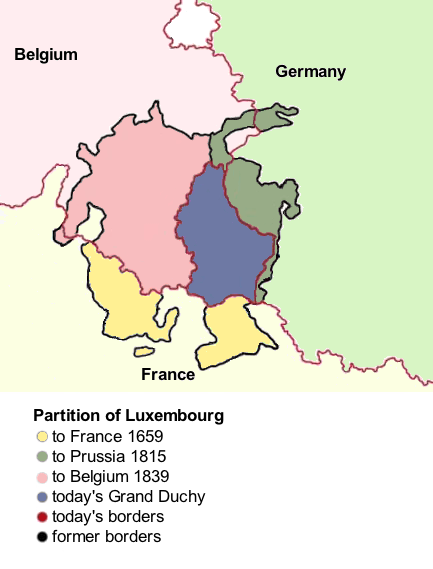 Luxracines, my genealogy society in Luxembourg, organized a field trip to the State Archives in Arlon, Belgium, and the archives of the Cercle Généalogique du Pays de Longwy in Mont-Saint-Martin, France, yesterday.
Luxracines, my genealogy society in Luxembourg, organized a field trip to the State Archives in Arlon, Belgium, and the archives of the Cercle Généalogique du Pays de Longwy in Mont-Saint-Martin, France, yesterday.
We departed from Luxembourg by bus for the Archives de l’État in Arlon in the Province of Luxembourg, Belgium. Greeted by the director of the archives, Mr. Michel TRIGALET, we were served coffee and cookies while he gave us an overview.

He explained how the archives were busy preparing to move the 18 kilometers of documents found in the present building as well as more kept in storage in different locations for a move into the new annex they are building. They have a small team of five persons and part-time personnel will be coming in to help. After completion of the new building, all collections will be moved there. They will have about 32 kilometers of archives in one place. The present home of the archives will be renovated to allow for better storage and preservation of the archives.

Following our short coffee break, Mr. TRIGALET took us to the reading room where he held a conference on the separation of the two Luxembourg(s). Instead of a slide presentation, Mr. TRIGALET had pulled records from the archives, laid them out on the two large tables, using them to supplement his presentation while explaining the intricacies of the historical period and showing us documents and maps relating to the subject.

Over time the borders of the Luxembourg went through various changes as seen in the above map. Although familiar with the events of the times, I did not know the effect it had on the countries involved or the people and the records they produced. Have you wondered why records are found in a specific archive and not where you would assume them to be?
The archives have records which pertain to Luxembourg but are kept in Arlon as they are included in collections which could not be separated. The history of Luxembourg explains the reason for this.
The Duchy of Luxembourg was annexed to France as a part of the département of Forêts (Forest Department) in 1795 during the French Revolution.
Luxembourg was liberated from French rule under the Treaty of Paris in 1814, following the defeat of Napoleon. The dark green area on the map (above), a part of the Duchy of Luxembourg, went to Prussia. At the Congress of Vienna in 1815 the Duchy became a Grand Duchy. The House of Orange received all of the Low Countries: Netherlands, Belgium, and Luxembourg. The Grand Duchy of Luxembourg was made up of the dark pink and the blue area on the map and came under the rule of Guillaume I (William I) of the Kingdom of Netherlands.
Following the Belgian Revolution of September 1830, most of the area was administered by the Belgian authorities while the capital, Luxembourg City, remained under Dutch control. A large part of the area around today’s western border of Luxembourg was administered by the two governments during the period 1831-1839. In 1833 a convention was concluded which simplified the lives of the people under the double rule.
Following the Treaty of London in 1839 which recognized the independence of the Kingdom of Belgium and Grand Duchy of Luxembourg, the partition between the two countries was established using mainly two criteria: linguistics and military reasons. All French-speaking territories went to Belgium. The Arlon region although German-speaking was given to neutral Belgium to remove the Athus-Arlon road which joined the road leading to Brussels from Arlon from the influence of the German Confederation.

The boundaries were vague and more precise limitations were set in 1843. Landmarks were set and the inventory of these can be found in the archives in Arlon.

These historical events led to inventories being made of the archives of Luxembourg and Belgium in preparation for moving them to the country of origin. The archivists worked on the inventories from 1840 to 1847 with the Luxembourg side taking more time as 1. the main archives of the times had been kept in Luxembourg and in Maastricht and 2. the number of archivists had decreased with the partition of the two countries.
The repatriation of archives was made more difficult by the fact that the collections of some institutions could not be separated as entries had been made in chronological order instead of by place (for ex. military and mortgage). This is one of the reasons Luxembourg researchers should consult the State Archives in Arlon when searching for information on their ancestors who were in the military or owned land during the time period before this final partition of the Grand Duchy of Luxembourg.


Repatriation continues even today as archivists are finding documents in their vast collections and return them to their country of origin. One example is this book of atlases for the Canton of Arlon from 1808. It was in such a bad condition that it had to be completely taken apart and restored. The double-sided cadastre plans now fill a box instead of being in book form (see box on the back table in the group photo below).

Following the conference, Mr. Trigalet took us into the area not normally open to the public.

He proudly showed us the oldest document in the archives, a charter of the Orval Abbey from 1163.


After a wonderful lunch at De Bouches à Oreilles Restaurant, we were back on the bus for a very short ride to the archives of the Cercle Généalogique du Pays de Longwy in Mont-Saint-Martin, France. We were received by their president Bernard BARTHELEMY and vice-president Aimé TARNUS, as well as, a few members eager to serve us. They have published an amazing amount of family books for the towns in the Longwy district which Luxracines has acquired for its library in Walferdange.

Our little trip which took us through three European countries was very enjoyable. It was a fascinating day with other genealogists, persons interested in the two Luxembourg(s) as it concerns their family and/or town histories.
I would like to thank Rob Deltgen, president of Luxracines, for sharing his photos and allowing me to use them.
© 2017, copyright Cathy Meder-Dempsey. All rights reserved.





Thank you Cathy for sharing. I will keep a copy of your post for future référence, as I have a few maternal lines in Luxembourg and Belgium.
LikeLiked by 1 person
Top Reportage! Thank you Cathy
LikeLiked by 1 person
Merci, Rob. Et war en scheinen Daag. Top organiséiert. Kudos for timing, great restaurant. You do a wonderful job.
LikeLike
You’re welcome, Annick. It’s great to learn something new. This was a real eye opener. Thank you.
LikeLike
Great info Cathy! Looks like it was a super fun trip!
LikeLiked by 1 person
I learn something new every time. Important things (for genealogists) are not always found in the history books. Thank you, Teresa.
LikeLike
Luxembourg sounds a little bit like the Poland of western Europe—constantly under attack and divided up among conquerors with borders changing. It sounds like a great trip.
LikeLiked by 1 person
Not only changing borders, there was also the different names in French, German, and Luxembourgish for the place names. Thankfully a kind researcher has a list on his website that I refer to often. Thank you, Amy.
LikeLiked by 1 person
Yes, I experience that also—Polish, Hebrew, Yiddish, German. A big mess!
LikeLiked by 1 person
Thank you Cathy. I always feel like I have gone on a trip with you, your stories are so detailed. Were you allowed to take a photograph of a charter of the Orval Abbey from 1163?
LikeLiked by 1 person
You’re welcome, Janice. No mention was made of photographs not being allowed. Our group of genealogists is used to visiting archives etc. and know not to use flash.
The Abbey of Orval produces beer and there was joking about the charter being the secret recipe.
Thank you, Janice.
LikeLike
What a fun day! I’m a wee bit jealous. 🙂
LikeLiked by 1 person
Thank you, Amberly. Not only fun, what I learned was so helpful for my research. 🙂
LikeLiked by 1 person
Hooray! That’s my kind of fun for sure. 😉
LikeLiked by 1 person
Mine eyes are opened! Great reporting Cathy. Saving this story for future reference. Wish I could have been there to look at the military records! Sounds like it was a wonderful day!
LikeLiked by 1 person
Thank you, Kathy. Glad I could “teach” you something new.
LikeLike